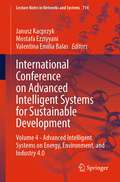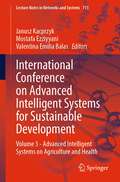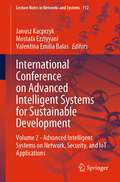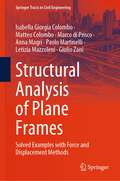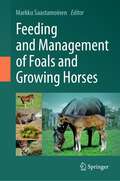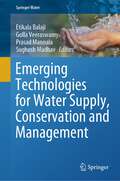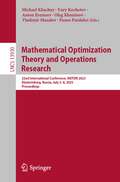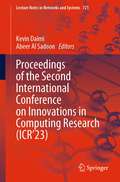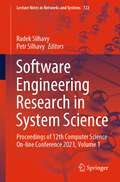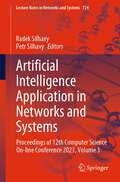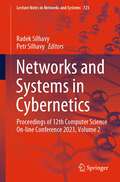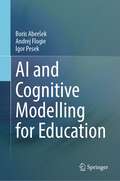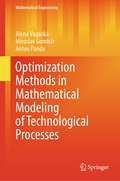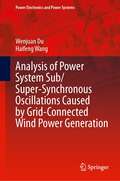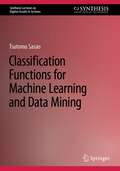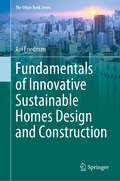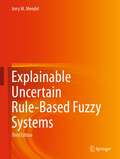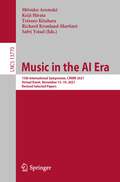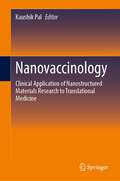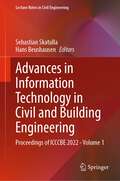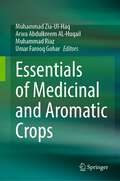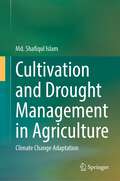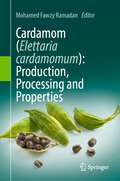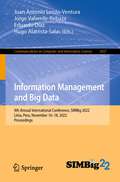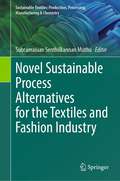- Table View
- List View
International Conference on Advanced Intelligent Systems for Sustainable Development: Volume 4 - Advanced Intelligent Systems on Energy, Environment, and Industry 4.0 (Lecture Notes in Networks and Systems #714)
by Janusz Kacprzyk Mostafa Ezziyyani Valentina Emilia BalasThis book describes the potential contributions of emerging technologies in different fields as well as the opportunities and challenges related to the integration of these technologies in the socio-economic sector. In this book, many latest technologies are addressed, particularly in the fields of computer science and engineering. The expected scientific papers covered state-of-the-art technologies, theoretical concepts, standards, product implementation, ongoing research projects, and innovative applications of Sustainable Development. This new technology highlights, the guiding principle of innovation for harnessing frontier technologies and taking full profit from the current technological revolution to reduce gaps that hold back truly inclusive and sustainable development. The fundamental and specific topics are Big Data Analytics, Wireless sensors, IoT, Geospatial technology, Engineering and Mechanization, Modeling Tools, Risk analytics, and preventive systems.
International Conference on Advanced Intelligent Systems for Sustainable Development: Volume 3 - Advanced Intelligent Systems on Agriculture and Health (Lecture Notes in Networks and Systems #713)
by Janusz Kacprzyk Mostafa Ezziyyani Valentina Emilia BalasThis book describes the potential contributions of emerging technologies in different fields as well as the opportunities and challenges related to the integration of these technologies in the socio-economic sector. In this book, many latest technologies are addressed, particularly in the fields of computer science and engineering. The expected scientific papers covered state-of-the-art technologies, theoretical concepts, standards, product implementation, ongoing research projects, and innovative applications of Sustainable Development. This new technology highlights, the guiding principle of innovation for harnessing frontier technologies and taking full profit from the current technological revolution to reduce gaps that hold back truly inclusive and sustainable development. The fundamental and specific topics are Big Data Analytics, Wireless sensors, IoT, Geospatial technology, Engineering and Mechanization, Modeling Tools, Risk analytics, and preventive systems.
International Conference on Advanced Intelligent Systems for Sustainable Development: Volume 2 - Advanced Intelligent Systems on Network, Security, and IoT Applications (Lecture Notes in Networks and Systems #712)
by Janusz Kacprzyk Mostafa Ezziyyani Valentina Emilia BalasThis book describes the potential contributions of emerging technologies in different fields as well as the opportunities and challenges related to the integration of these technologies in the socio-economic sector. In this book, many latest technologies are addressed, particularly in the fields of computer science and engineering. The expected scientific papers covered state-of-the-art technologies, theoretical concepts, standards, product implementation, ongoing research projects, and innovative applications of Sustainable Development. This new technology highlights, the guiding principle of innovation for harnessing frontier technologies and taking full profit from the current technological revolution to reduce gaps that hold back truly inclusive and sustainable development. The fundamental and specific topics are Big Data Analytics, Wireless sensors, IoT, Geospatial technology, Engineering and Mechanization, Modeling Tools, Risk analytics, and preventive systems.
Structural Analysis of Plane Frames: Solved Examples with Force and Displacement Methods (Springer Tracts in Civil Engineering)
by Isabella Giorgia Colombo Matteo Colombo Marco di Prisco Anna Magri Paolo Martinelli Letizia Mazzoleni Giulio ZaniThis textbook presents applicative examples of the main methods of structural analysis of statically indeterminate frame structures. It begins with a brief description of the kinematic analysis for plane frames. The Force Method, the Displacement Method and the Mixed method are applied for the solutions of statically indeterminate plane structures. The book first deals with the solution of simple reference cases where the most common structural situations, such as inclined rods, extensional and rotational springs, thermal variations, symmetry and anti-symmetry (just to mention some of them) are treated singularly. It then reports the complete solution of complex plane frames where the most common structural situations, individually analyzed in the previous chapter, are combined.Given the diverse and wide range of examples covered, the volume represents an ideal learning resource for students of Civil and Building Engineering and Architecture, and a valuable reference guide for structural engineering professionals.
Feeding and Management of Foals and Growing Horses
by Markku SaastamoinenThis volume offers the latest research-based findings to equip professionals involved in the breeding and raising of horses. Contributions were carefully selected and prepared by leading experts in their fields. The collection starts with a discussion of pregnant and lactating mares, followed by details on foal development, nutritional requirements, and feeding practices under different conditions. Special sections on young horses in training, parasite control as well as on health risks related to nutrition and exercise round off this unique and easy-to-read reference.Today’s horses perform variety of roles and there are many categories of horses based on their breed, size and use, making adequate nutrition challenging. This book considers the links between health, proper dietary treatment and management practices to increase our understanding of the needs of growing horses. In addition, it highlights various innovations in equine nutrition and management to ensure animal wellbeing.Veterinarians, animal nutritionist, and all stakeholders and people working in the horse industry will benefit from the presented knowledge. This book fills a literature gap to prevent health consequences and strengthen performance and physical development in equines.
Emerging Technologies for Water Supply, Conservation and Management (Springer Water)
by Etikala Balaji Golla Veeraswamy Prasad Mannala Sughosh MadhavThis book deals with the role of emerging technologies such as remote sensing and GIS and artificial intelligence/machine learning in water supply, conservation and management for sustainable development. These are low-cost new technologies that address current challenges dealing with large data sets, such as identifying spatial and temporal variations in water quality parameters and contaminants, groundwater potential zones and water supply and management issues. This book is helpful to show the paths of reducing the burden of time and cost and is the alternative options for the conventional practices in water supply, conservation and management. Further, the outcomings of this book are helpful for policy makers, researchers and readers.
Mathematical Optimization Theory and Operations Research: 22nd International Conference, MOTOR 2023, Ekaterinburg, Russia, July 2–8, 2023, Proceedings (Lecture Notes in Computer Science #13930)
by Michael Khachay Yury Kochetov Anton Eremeev Oleg Khamisov Vladimir Mazalov Panos PardalosThis book constitutes the refereed proceedings of the 22nd International Conference on Mathematical Optimization Theory and Operations Research, MOTOR 2023, held in Ekaterinburg, Russia, during July 2–8, 2023. The 28 full papers and 1 short paper included in this book were carefully reviewed and selected from 89 submissions. They were organized in topical sections as follows: Mathematical programming and applications; discrete and combinatorial optimization; stochastic optimization; scheduling; game theory; and optimal control and mathematical economics. The book also contains one invited talk in full paper length.
Proceedings of the Second International Conference on Innovations in Computing Research (Lecture Notes in Networks and Systems #721)
by Kevin Daimi Abeer Al SadoonThe Second International Conference on Innovations in Computing Research (ICR’23) brings together a diverse group of researchers from all over the world with the intent of fostering collaboration and dissemination of the innovations in computing technologies. The conference is aptly segmented into six tracks: Data Science, Computer and Network Security, Health Informatics and Medical Imaging, Computer Science and Computer Engineering Education, Internet of Things, and Smart Cities/Smart Energy. These tracks aim to promote a birds-of-the-same-feather congregation and maximize participation. The Data Science track covers a wide range of topics including complexity score for missing data, deep learning and fake news, cyberbullying and hate speech, surface area estimation, analysis of gambling data, car accidents predication model, augmenting character designers’ creativity, deep learning for road safety, effect of sleep disturbances on the quality of sleep, deep learning-based path-planning, vehicle data collection and analysis, predicting future stocks prices, and trading robot for foreign exchange. Computer and Network Security track is dedicated to various areas of cybersecurity. Among these are decentralized solution for secure management of IoT access rights, multi-factor authentication as a service (MFAaaS) for federated cloud environments, user attitude toward personal data privacy and data privacy economy, host IP obfuscation and performance analysis, and vehicle OBD-II port countermeasures. The Computer Science and Engineering Education track enfolds various educational areas, such as data management in industry–academia joint research: a perspective of conflicts and coordination in Japan, security culture and security education, training and awareness (SETA), influencing information security management, engaging undergraduate students in developing graphical user interfaces for NSF funded research project, and emotional intelligence of computer science teachers in higher education. On the Internet of Things (IoT) track, the focus is on industrial air quality sensor visual analytics, social spider optimization meta-heuristic for node localization optimization in wireless sensor networks, and privacy aware IoT-based fall detection with infrared sensors and deep learning. The Smart Cities and Smart Energy track spans various areas, which include, among others, research topics on heterogeneous transfer learning in structural health monitoring for high-rise structures and energy routing in energy Internet using the firefly algorithm.
Software Engineering Research in System Science: Proceedings of 12th Computer Science On-line Conference 2023, Volume 1 (Lecture Notes in Networks and Systems #722)
by Radek Silhavy Petr SilhavyThe latest advancements in software engineering are featured in this book, which contains the refereed proceedings of the part of the 12th Computer Science Online Conference 2023 (CSOC 2023), held online in April 2023. The software engineering research in system science session is focusing on the importance of software engineering in the field of system science. This section provides a platform for researchers to share their insights on modern research methodologies, machine learning, and statistical learning techniques in software engineering research. The session provides a unique opportunity for researchers and industry experts to explore the latest trends in software engineering and inspire future research directions. This session brings together experts from different fields to present their research and discuss the latest challenges and opportunities. One of the key themes of this session is the application of artificial intelligence in software engineering. Researchers are exploring how techniques can be used to automate various aspects of software engineering, such as testing, debugging, and maintenance. This helps improve the quality and efficiency of software development processes.
Artificial Intelligence Application in Networks and Systems: Proceedings of 12th Computer Science On-line Conference 2023, Volume 3 (Lecture Notes in Networks and Systems #724)
by Radek Silhavy Petr SilhavyThe application of artificial intelligence in networks and systems is a rapidly evolving field that has the potential to transform a wide range of industries. The refereed proceedings in this book is from the Artificial Intelligence Application in Networks and Systems session of the Computer Science Online Conference 2023 (CSOC 2023), which was held online in April 2023. The section brings together experts from different fields to present their research and discuss the latest trends and challenges. One of the key themes in this section is the development of intelligent systems that can learn, adapt, and optimize their performance in real time. Researchers are exploring how AI algorithms can be used to create autonomous networks and systems that can make decisions without human intervention. Furthermore, this section highlights the use of AI in improving network performance and efficiency. Researchers are exploring how AI algorithms can be used to optimize network routing, reduce congestion, and improve the quality of service. These efforts can help organizations save costs and improve user experience.
Networks and Systems in Cybernetics: Proceedings of 12th Computer Science On-line Conference 2023, Volume 2 (Lecture Notes in Networks and Systems #723)
by Radek Silhavy Petr SilhavyThe Networks and Systems in Cybernetics section continues to be a highly relevant and rapidly evolving area of research, encompassing modern advancements in informatics and cybernetics within network and system contexts. This field is at the forefront of developing cutting-edge technologies that can tackle complex challenges and improve various aspects of our lives. The latest research in this field is featured in this book, which provides a comprehensive overview of recent methods, algorithms, and designs. The book comprises the refereed proceedings of the Cybernetics Perspectives in Systems session of the 12th Computer Science Online Conference 2023 (CSOC 2023), which was held online in April 2023. The book offers a unique opportunity to explore the latest advances in cybernetics and informatics and their applications in a range of domains. It brings together experts from various disciplines to share their insights and collaborate on research that can shape the future of our world. One of the key themes of this section is the application of cybernetics in intelligent systems. This area has significant potential to revolutionize a range of industries. Researchers are exploring how cybernetic principles can be used to create intelligent systems that can learn, adapt, and optimize their performance over time.
AI and Cognitive Modelling for Education
by Boris Aberšek Andrej Flogie Igor PesekThis book offers a groundbreaking approach to bridging the gap between various disciplines involved in cognitive modeling in education. By drawing on the fields of learning, neuro science, cognitive science, neurobiology, and computer science, it provides a new perspective on how we can integrate these disciplines with education to create more effective learning environments. The main objective of this book is to delve into the ethical, sociological, and technological questions surrounding the introduction of intelligent and smart learning environments in education. By analyzing these issues, this book aims to bridge the gap between the various disciplines involved in cognitive modeling and education, while highlighting the benefits and risks associated with these advancements. With the emergence of AI-based tutors, coaches, and learning environments, students now have access to a new type of self-learning and self-training that was previously unavailable. Distance learning has become increasingly popular in recent years, and the use of computer-assisted learning tools has revolutionized the way we think about education. The goal of education must be to instill in students a desire to learn for themselves, and this can only be achieved through active, self-directed, and reflective learning. With intelligent tutoring systems, students are empowered to take an active role in their own education, rather than simply being passive recipients of information. This book offers practical strategies for teachers to facilitate this transition, enabling them to act as facilitators and guides rather than one-way communicators. By embracing this new approach to education, we can help students become lifelong learners who are equipped with the skills they need to succeed in the 21st century. As we cannot predict the future with certainty, the true effects of education may only be revealed in the long run, making it critical to understand the potential consequences of introducing these new learning tools. By exploring these complex topics, this book offers valuable insights for educators, policymakers, and anyone interested in the future of education.
Optimization Methods in Mathematical Modeling of Technological Processes (Mathematical Engineering)
by Alena Vagaská Miroslav Gombár Anton PandaThis book focuses on selected methods of applied mathematics that are aimed at mathematical optimization, with an emphasis on their application in engineering practice. It delves into the current mathematical modeling of processes and systems, with a specific focus on the optimization modeling of technological processes. The authors discuss suitable linear, convex, and nonlinear optimization methods for solving problems in engineering practice. Real-world examples and data are used to numerically illustrate the implementation of these methods, utilizing the popular MATLAB software system and its extension to convex optimization. The book covers a wide range of topics, including mathematical modeling, linear programming, convex programming, and nonlinear programming, all with an engineering optimization perspective. It serves as a comprehensive guide for engineers, researchers, and students interested in the practical application of optimization methods in engineering.
Analysis of Power System Sub/Super-Synchronous Oscillations Caused by Grid-Connected Wind Power Generation (Power Electronics and Power Systems)
by Wenjuan Du Haifeng WangThis book provides a systematic introduction to power system sub/super-synchronous oscillations caused by grid-connected wind power generation. The authors look at why oscillations occur and present methods for examining the risk of oscillations. Coverage includes state-space model based analysis and impedance model based analysis, which are the two main methods for examining the power system sub/super-synchronous oscillations. In addition, new methods for examining oscillations in wind farms are proposed. Analysis of Power System Sub/Super-Synchronous Oscillations Caused by Grid-connected Wind Power Generation provides researchers and students with a single-volume introduction to the subject and will be a valuable professional reference for practicing engineers looking for solutions to oscillation problems.
Classification Functions for Machine Learning and Data Mining (Synthesis Lectures on Digital Circuits & Systems)
by Tsutomu SasaoThis book introduces a novel perspective on machine learning, offering distinct advantages over neural network-based techniques. This approach boasts a reduced hardware requirement, lower power consumption, and enhanced interpretability. The applications of this approach encompass high-speed classifications, including packet classification, network intrusion detection, and exotic particle detection in high-energy physics. Moreover, it finds utility in medical diagnosis scenarios characterized by small training sets and imbalanced data. The resulting rule generated by this method can be implemented either in software or hardware. In the case of hardware implementation, circuit design can employ look-up tables (memory), rather than threshold gates.The methodology described in this book involves extracting a set of rules from a training set, composed of categorical variable vectors and their corresponding classes. Unnecessary variables are eliminated, and the rules are simplified before being transformed into a sum-of-products (SOP) form. The resulting SOP exhibits the ability to generalize and predict outputs for new inputs. The effectiveness of this approach is demonstrated through numerous examples and experimental results using the University of California-Irvine (UCI) dataset.This book is primarily intended for graduate students and researchers in the fields of logic synthesis, machine learning, and data mining. It assumes a foundational understanding of logic synthesis, while familiarity with linear algebra and statistics would be beneficial for readers.
Fundamentals of Innovative Sustainable Homes Design and Construction (The Urban Book Series)
by Avi FriedmanThis book offers ideas and practices on contemporary design concepts and illustrates them with plans and photographs of outstanding examples. Current planning and design modes of dwellings and neighborhoods are facing challenges of philosophy and form. Past approaches no longer sustain new demands and require innovative thinking. The need for a new outlook is propelled by fundamental changes that touch upon environmental, economic and social aspects. The depletion of non-renewable natural resources and climate change are a few of the environmental challenges. Increasing costs of material, labor, land and infrastructure have posed economic challenges with affordability being paramount among them. Social challenges are also drawing the attention of designers, builders and homeowners. Walkable communities, aging in place and multigenerational living are some of the concepts considered. In addition, live-work environments have become part of the economic reality for those who wish to work from home—which has become possible through digital advances. The text would be of interest to scholars working in: architecture, urban planning, and construction.
Explainable Uncertain Rule-Based Fuzzy Systems
by Jerry M. MendelThe third edition of this textbook presents a further updated approach to fuzzy sets and systems that can model uncertainty — i.e., “type-2” fuzzy sets and systems. The author demonstrates how to overcome the limitations of classical fuzzy sets and systems, enabling a wide range of applications, from time-series forecasting to knowledge mining to classification to control and to explainable AI (XAI). This latest edition again begins by introducing classical (type-1) fuzzy sets and systems, and then explains how they can be modified to handle uncertainty, leading to type-2 fuzzy sets and systems. New material is included about how to obtain fuzzy set word models that are needed for XAI, similarity of fuzzy sets, a quantitative methodology that lets one explain in a simple way why the different kinds of fuzzy systems have the potential for performance improvements over each other, and new parameterizations of membership functions that have the potential for achieving even greater performance for all kinds of fuzzy systems. For hands-on experience, the book provides information on accessing MATLAB, Java, and Python software to complement the content. The book features a full suite of classroom material.
Music in the AI Era: 15th International Symposium, CMMR 2021, Virtual Event, November 15–19, 2021, Revised Selected Papers (Lecture Notes in Computer Science #13770)
by Mitsuko Aramaki Keiji Hirata Tetsuro Kitahara Richard Kronland-Martinet Sølvi YstadThis book constitutes the refereed proceedings and revised selected papers from the 15th International Symposium on Music in the AI Era, CMMR 2021, which took place during November 15–19, 2021 as a virtual event. The 24 full papers included in this book were carefully reviewed and selected from 48 submissions. The papers are grouped in thematical sessions on Music technology in the IA era; Interactive systems for music; Music Information Retrieval and Modeling; and Music and Performance Analysis.
Nanovaccinology: Clinical Application of Nanostructured Materials Research to Translational Medicine
by Kaushik PalThis book provides an overview of the cumulative work on a driving force for innovation in medicine and modern healthcare, boosting advances in therapeutics, biosensors, vaccines, and clinical systems. The work presented shows how nanoparticles have been investigated as vaccine adjuvants because they possess chemical and structural properties that improve immunogenicity as well as the use of nanotechnology in the construction of immunization systems that has developed into the field of viral nanovaccinology. The volume highlights potential areas of research, innovation, and development of finished products for future commercialization and significant research exploration through nanoparticles that prove capable of surmounting most of the barriers like toxicity issues, clearance from biological system, DNA instability, and differences in expression systems. The contributing authors review the primary literature on principles, limitations, and recent breakthroughs in nanoparticle-based antigen delivery vehicles, their use in different diseases, the major bottlenecks, and related issues. Highlighting advances in nanoparticle engineering and the understanding of nanoparticle characteristics as well as critical legacy work dome in the field of nanobiotechnology, the book is ideal for a range of researchers and students in the pure and applied sciences devoted to nanomaterials, vaccinology, and translational medicine.
Advances in Information Technology in Civil and Building Engineering: Proceedings of ICCCBE 2022 - Volume 1 (Lecture Notes in Civil Engineering #357)
by Sebastian Skatulla Hans BeushausenThis book gathers the latest advances, innovations, and applications in the field of information technology in civil and building engineering, presented at the 19th International Conference on Computing in Civil and Building Engineering (ICCCBE), held in Cape Town, South Africa on October 26-28, 2022. It covers highly diverse topics such as BIM, construction information modeling, knowledge management, GIS, GPS, laser scanning, sensors, monitoring, VR/AR, computer-aided construction, product and process modeling, big data and IoT, cooperative design, mobile computing, simulation, structural health monitoring, computer-aided structural control and analysis, ICT in geotechnical engineering, computational mechanics, asset management, maintenance, urban planning, facility management, and smart cities. Written by leading researchers and engineers, and selected by means of a rigorous international peer-review process, the contributions highlight numerous exciting ideas that will spur novel research directions and foster multidisciplinary collaborations.
Essentials of Medicinal and Aromatic Crops
by Muhammad Zia-Ul-Haq Arwa Abdulkreem AL-Huqail Muhammad Riaz Umar Farooq GoharMedicinal and aromatic crops (MACs) are high-value crops since the natural products obtained from them are low-volume high-value commodities that have numerous applications in various sectors such as the food, beverage, food supplement, flavor and fragrance, perfumery and cosmetics, pharmaceutical and aromatherapy industries. In addition, the plant biomass is used in the production of teas and medical applications in traditional and also modern medicines. MACs are important mainly because they contain plant secondary metabolites such as essential oils, alkaloids, glygosides, saponins, tannins, vitamins and other bioactives. Plant secondary metabolites are differentiated from plant primary metabolites of photosynthesis and respiration since they are directly involved in growth and development of plants. Some MACs are used as spices and culinary herbs since they contain mainly essential oils, and are used as tonic to the digestive system, appetite modification and other systems and may facilitate nutrient uptake and utilization from various foods. A significant amount of MACs and their natural products have also demonstrated antimicrobial, antifungal and bactericidal activity and significant antioxidant capacity. In the past, MACs and their natural products have been used as a source for various medicines, in food and beverage production and in aroma products. Essentials of Medicinal and Aromatic Crops summarizes the current knowledge on medicinal and aromatic crops, including the agronomical practices of important MACs and their products, their beneficial effects and utilization of MAP and their products. The chapters provide a comprehensive guide to the most important and used medicinal and aromatic crops and their use in functional foods, nutraceuticals and as bioactives against various ailments, providing researchers, teachers, chemists, food scientists, agronomists and agroecologists in academia, industry and government a fully up to date singular source on this important topic.
Cultivation and Drought Management in Agriculture: Climate Change Adaptation
by Md. Shafiqul IslamThis book represents the background of the Barind Tract of Bangladesh with the proximity of drought information, conceptual and logic of the books, history, definition and perception on drought and climate scenario and how people understand underlying causes, impacts and consequences of drought in agriculture, environment, human health and society. It also states the trend and severity of drought of Barind Tract. This book gives the local response to cope, mitigation and adaptation to agricultural drought. The book also addresses the gender response in the hardship of drought in the rural areas. It also elicits the local and indigenous methods of drought prediction and sustainable cultivation and management of drought in agriculture.
Cardamom (Elettaria cardamomum): Production, Processing and Properties
by Mohamed Fawzy RamadanCardamom [Elettaria cardamomum (L.) Maton is recognized for its unique taste and aroma. As the third most expensive spice after saffron and vanilla, Cardamom has been used as a spice and flavoring ingredient in food and is rich in bioactive constituents including minerals, carbohydrates, proteins, lipids, essential oils, terpenoids, flavonoids and carotenoids. Cardamom essential oil (CEO) and other bioactive compounds accumulated in cardamom capsules contribute to their characteristic aroma and utility as a novel food and nutraceutical. CEO from capsules possesses monoterpene constituents such as α-terpineol, 1,8-cineole, α-pinene, linalyl acetate, linalool, and nerolidol as well as the ester of α-terpinyl acetate. Flavonoids, anthocyanins, terpenoids, alkaloids, and other cardamom phenolics have shown high MIC values against Campylobacter species and reduced Bacillus subtilis spore. CEO loses its flavor rapidly upon storing under a normal environment. The change in the aroma or flavor could also cause changes in the constituents of its phytochemicals.Cardamom (Elettaria cardamomum): Production, Processing & Properties aims to create a multidisciplinary forum of discussion on E. cardamomum, emphasizing its botany, ethnobotanical, cultivation, horticultural practices, post-harvest, marketability, phytochemistry, extraction protocols, biochemistry, nutritional value, functionality, ethnomedicinal applications and and processing specifics. The book discusses the botanical distribution, phytochemical constituents, food applications and biological activities of cardamom capsule extracts and essential oil. Also, the text discusses the potential applications of E. cardamomum in food, cosmetics and pharmaceutical products. This book is the first of its kind, a full research work dedicated specifically to cardamom applications and benefits that will be of value for researchers from multiple fields.
Information Management and Big Data: 9th Annual International Conference, SIMBig 2022, Lima, Peru, November 16–18, 2022, Proceedings (Communications in Computer and Information Science #1837)
by Juan Antonio Lossio-Ventura Jorge Valverde-Rebaza Eduardo Díaz Hugo Alatrista-SalasThis book constitutes the refereed proceedings of the 9th Annual International Conference on Information Management and Big Data, SIMBig 2022, held in Lima, Peru, during November 16–18, 2022.The 18 full papers and 1 short paper included in this book were carefully reviewed and selected from 50 submissions. The volume presented novel methods for the analysis and management of large data, in fields like Artificial Intelligence (AI), Data Science, Machine Learning, Natural Language Processing, Semantic Web, Data-driven Software Engineering, Health Informatics.
Novel Sustainable Process Alternatives for the Textiles and Fashion Industry (Sustainable Textiles: Production, Processing, Manufacturing & Chemistry)
by Subramanian Senthilkannan MuthuEnvironmental impacts created by the textiles and fashion sector are well known and acknowledged by various stakeholders involved in the entire supply chain. The lifecycle of textile products creates various impacts to the environment and any attempts to alleviate them are highly welcomed. The whole sector is keen to investigate novel sustainable alternatives in terms of raw materials, processes, approaches to make the entire textiles and fashion sector more sustainable. This broad category of novel sustainable alternatives can be split into three subtopics: novel raw material alternatives, novel process alternative and novel alternative approaches. This volume provides cases describing novel sustainable process alternatives for the textiles and fashion industry.
